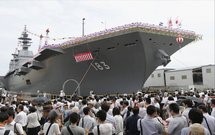 On 6 August 2013, Japan launched its largest warship since World War II in a fresh demonstration of Tokyo’s steadily expanding naval capabilities. The unveiling of the destroyer — with a conspicuously large flight deck — has drawn flak from its neighbors, especially long standing regional rival China, which in the past decade has embarked on a massive program of military modernization.
On 6 August 2013, Japan launched its largest warship since World War II in a fresh demonstration of Tokyo’s steadily expanding naval capabilities. The unveiling of the destroyer — with a conspicuously large flight deck — has drawn flak from its neighbors, especially long standing regional rival China, which in the past decade has embarked on a massive program of military modernization.
Izumo is designed to be a vessel which is conscious of the Chinese Navy, and to support civil disaster relief operation and the United Nations Peace Keeping Operations (PKO). The planned helicopter destroyer will have a length some 25% greater than the 197 meter 16DDH Hyuga, commissioned in 2009, and its sister ship Ise, which entered service in 2011. At 250 meters (820 feet), the 22DDH is comparable to the Italian Cavour of 244. The full-length aircraft carrier type deck extends from the bow to the stern. The light displacement was reported as 20,000 tons, a 44% increase over the 16DDH, while the full loaded displacement is probably comparable to the 27,000 ton displacement of the Italian Cavour.
Constitutional Limitations
Domestically, Japan faces a tricky situation. When it has tried to take measures to protect and make provision to defend the country’s sovereignty and territorial integrity from possible external threat, the pacifist constitution comes on the way. Not surprisingly, the "helicopter destroyer" looks like an aircraft carrier, which raised questions that it would violate Japan's pacifist Constitution. As in the Vietnam War and the war in Iraq, aircraft carriers have been a main maritime base of attack for the US military. In light of the constitutional ban in Article 9 on possessing "land, sea and air forces, as well as other war potential," the government in 1988 issued a statement that said, "Because offensive aircraft carriers exceed the war potential needed for a minimum level of self-defense, possession of such ships is prohibited by the Constitution."
The Japanese government says that the Izumo, which can be used to launch helicopters, still doesn’t cross the line. But the almost 20,000-ton vessel is capable of carrying up to fourteen helicopters, with a maximum of five taking off and landing at once. Tokyo says that the Izumo cannot carry planes, since it lacks the catapults necessary for seaborne take-off. Instead, officials maintain that the carrier will be used for disaster and rescue missions — in the aftermath of a tsunami, perhaps — as well as for responding to “various contingencies in waters near Japan”.
The main component of the MSDF fleet is its four destroyer flotillas, each with eight destroyers and eight helicopters. Those numbers were arrived at during the Cold War to counter Soviet submarines plying the waters around Japan. More recently, the main trigger comes from China as Chinese navy has been strengthening its sea attack capabilities.
Reactions from China and North Korea
The launch of Izumo causes concern in China, which remains embroiled in a territorial dispute with Japan over the Diaoyu/Senkaku Islands. The islands are administered by Japan, but claimed by both sides. For months, ships from both countries have been conducting patrols around the islet chain. Tensions over the Senkakus, along with China’s heavy spending on defense and military modernization, have heightened calls in Japan for beefed-up naval and air forces. China recently began operating an aircraft carrier, the Liaoning, a refurbished Soviet-era vessel, and is reportedly moving forward with the construction of another that will be domestically built.
The symbolism of choosing 6 August as the anniversary of the atomic bombing of Hiroshima in 1945 to unveil Japan's largest post-WWII 'aircraft carrier' is sure not to go unnoticed in Beijing.
This is the biggest warship that Japan has unveiled since World War II as part of a plan to bolster its defense of territorial claims in disputed waters. The $1.2 billion Japanese-made destroyer, revealed at a ceremony in Yokohama on 6 August 2013, will go into service in March 2015. The conservative government of Abe is considering modifications to constitutional restrictions. Beijing has long viewed Japanese military activities with suspicion and accused Tokyo of failing to fully atone for 20th century wartime atrocities against China.
As was expected, reactions from North Korea were also similar to that of China. On 7 August, North Korea warned that Japan was following a militarization program that had already crossed “the danger line.” A commentary by the official Korean Central News Agency highlighted a Japanese Defense Ministry paper published in July 2013 that stressed the need to boost the strength and range of forces required to protect Japan’s far-flung territories. The paper specifically called for a “comprehensive containment capability” to counter ballistic missile threats from North Korea.
Implications
As regards China, it has created a situation in the region where other nations are stressing their focus on strengthening their defence capabilities. This way, China has triggered a veritable arm race. Arms build-ups always come with people willing to use them. There lies the danger. Mutual deterrence must not come at the cost of Asian prosperity and that is the biggest challenge that Asia faces today. The launch of Izumo should be seen from this perspective.
Courtesy : Institute of Peace and Conflict Studies (http://www.ipcs.org)